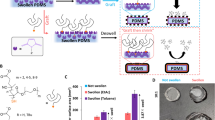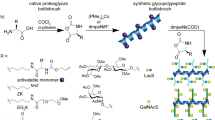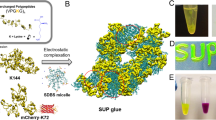Abstract
The external region of a cell membrane, known as the glycocalyx, is dominated by glycosylated molecules1,2,3 which direct specific interactions such as cell–cell recognition and contribute to the steric repulsion that prevents undesirable non-specific adhesion of other molecules and cells. Mimicking the non-adhesive properties of a glycocalyx provides a potential solution to the clinical problems, such as thrombosis4, that are associated with implantable devices owing to non-specific adsorption of plasma proteins. Here we describe a biomimetic surface modification of graphite using oligosaccharide surfactant polymers, which, like a glycocalyx, provides a dense and confluent layer of oligosaccharides. The surfactant polymers consist of a flexible poly(vinyl amine) with dextran and alkanoyl side chains. We show that alkanoyl side chains assemble on graphite through hydrophobic interaction and epitaxial adsorption. This constrains the polymer backbone to lie parallel to the substrate, with solvated dextran side chains protruding into the aqueous phase, creating a glycocalyx-like coating. The resulting biomimetic surface is effective in suppressing protein adsorption from human plasma protein solution.
This is a preview of subscription content, access via your institution
Access options
Subscribe to this journal
Receive 51 print issues and online access
$199.00 per year
only $3.90 per issue
Buy this article
- Purchase on Springer Link
- Instant access to full article PDF
Prices may be subject to local taxes which are calculated during checkout




Similar content being viewed by others
References
Evans, W. H. & Graham, J. M. Membrane Structure and Function 1–86 (Oxford Univ. Press, New York, 1991).
Fukuda, M. in Molecular Glycobiology (eds Fukuda, M. & Hindsgaul, O.) 1–52 (Oxford Univ. Press, New York, 1994).
Bongrand, P. in Physical Basis of Cell-Cell Adhesion (ed. Bongrand, P.) 1–37 (CRC, Boca Raton, FL, 1987).
Salzman, E. W., Merrill, E. W. & Hent, K. C. in Hemostasis and Thrombosis3rd edn (eds Colman, R. W., Hirsh, J., Marder, V. J. & Salzman, E. W.) 1469–1485 (Lippincott, Philadelphia, 1994).
Helmus, M. N. & Hubbell, J. A. Materials selection. Cardiovasc. Pathol. (Suppl.) 2, 53S–71S (1993).
Badesso, R. & Pinschmidt, R. K. Jr Synthesis of amine functional homopolymers with N-ethenylformamide. Polym. Mater. Sci. Eng. 69, 251–252 (1993).
Qiu, Y., Zhang, T., Ruegsegger, M. & Marchant, R. E. Novel nonionic oligosaccharide surfactant polymers derived from poly(vinyl amine) with pendant dextran and hexanoyl groups. Macromolecules 31, 165–171 (1998).
Qiu, Y. & Marchant, R. E. Protein resistant biomaterial surfaces derived from physically immobilized novel oligosaccharide surfacant molecules. Trans. Soc. Biomater. 20, 224 (1997).
Putman, C. A. J., Vanderwerf, K. O., De Grooth, B. G., Van Hulst, N. F. & Greve, J. Tapping mode atomic-force microscopy in liquid. Appl. Phys. Lett. 64, 2454–2456 (1994).
Zhang, T. & Marchant, R. E. Novel polysaccharide surfactants: The effect of hydrophobic and hydrophilic chain length on surface active properties. J. Colloid Interface Sci. 177, 419–426 (1996).
Groszek, A. Selective adsorption at graphite/hydrocarbon interfaces. Proc. R. Soc. Lond. A 314, 473–498 (1970).
McGonigal, G. C., Bernhardt, R. H. & Thompson, D. J. Imaging alkane layers at the liquid/graphite interface with the scanning tunneling microscope. Appl. Phys. Lett. 57, 28–30 (1990).
Rabe, J. P. & Buchholz, S. Commensurability and mobility in two-dimensional molecular patterns on graphite. Science 253, 424–427 (1991).
Wellinghoff, S., Rybnikar, F. & Baer, E. Epitaxial crystallization of polyethylene. J. Macromol. Sci. Phys.B 10, 1–39 (1974).
Whitman, J. C. & Lotz, B. Epitaxial crystallization of polymers on organic and polymeric substrates. Prog. Polym. Sci. 15, 909–948 (1990).
Manne, S. & Gaub, H. E. Molecular organization of surfactants at solid-liquid interfaces. Science 270, 1480–1482 (1995).
Manne, S., Cleveland, J. P., Gaub, H. E., Stucky, G. D. & Hansma, P. K. Direct visualization of surfactant hemimicelles by force microscopy of the electrical double-layer. Langmuir 10, 4409–4413 (1994).
Milner, S. T. Polymer brushes. Science 251, 905–914 (1991).
Sharma, R. Small-molecule surfactant adsorption, polymer surfactant adsorption, and surface solubilization — An overview. ACS Symp. Ser. 615, 1–20 (1995).
Golander, C.-G. et al. in Poly(ethylene glycol) Chemistry (ed. Harris, J. M.) 221–246 (Plenum, New York, 1992).
Österberg, E. et al. Protein-rejecting ability of surface bound dextran in end-on and side-on configurations: Comparison to PEG. J. Biomed. Mater. Res. 29, 741–747 (1995).
Nemanich, R. J., Lucovsky, G. & Solin, S. A. Infrared active optical vibrations of graphite. Solid State Commun. 23, 117–120 (1977).
Acknowledgements
We acknowledge the financial support for this work provided by the National Institutes of Health and the Whitaker Foundation, and use of the AFM and IR facilities at the Center for Cardiovascular Biomaterials, CWRU.
Author information
Authors and Affiliations
Corresponding author
Rights and permissions
About this article
Cite this article
Holland, N., Qiu, Y., Ruegsegger, M. et al. Biomimetic engineering of non-adhesive glycocalyx-like surfaces using oligosaccharide surfactant polymers. Nature 392, 799–801 (1998). https://doi.org/10.1038/33894
Received:
Accepted:
Published:
Issue Date:
DOI: https://doi.org/10.1038/33894
This article is cited by
-
Scanning probe microscopy
Nature Reviews Methods Primers (2021)
-
Adsorption mechanism, secondary structure and local distribution of proteins at polyelectrolyte brushes
Colloid and Polymer Science (2020)
-
Modeling integrin and plasma-polymerized pyrrole interactions: chemical diversity relevance for cell regeneration
Scientific Reports (2019)
-
Hierarchical self-assembly and emergent function of densely glycosylated peptide nanofibers
Communications Chemistry (2019)
-
Potential Influence of Endothelial Adsorption on the Delayed Time to Maximum Concentration of Biopharmaceuticals
European Journal of Drug Metabolism and Pharmacokinetics (2018)
Comments
By submitting a comment you agree to abide by our Terms and Community Guidelines. If you find something abusive or that does not comply with our terms or guidelines please flag it as inappropriate.



